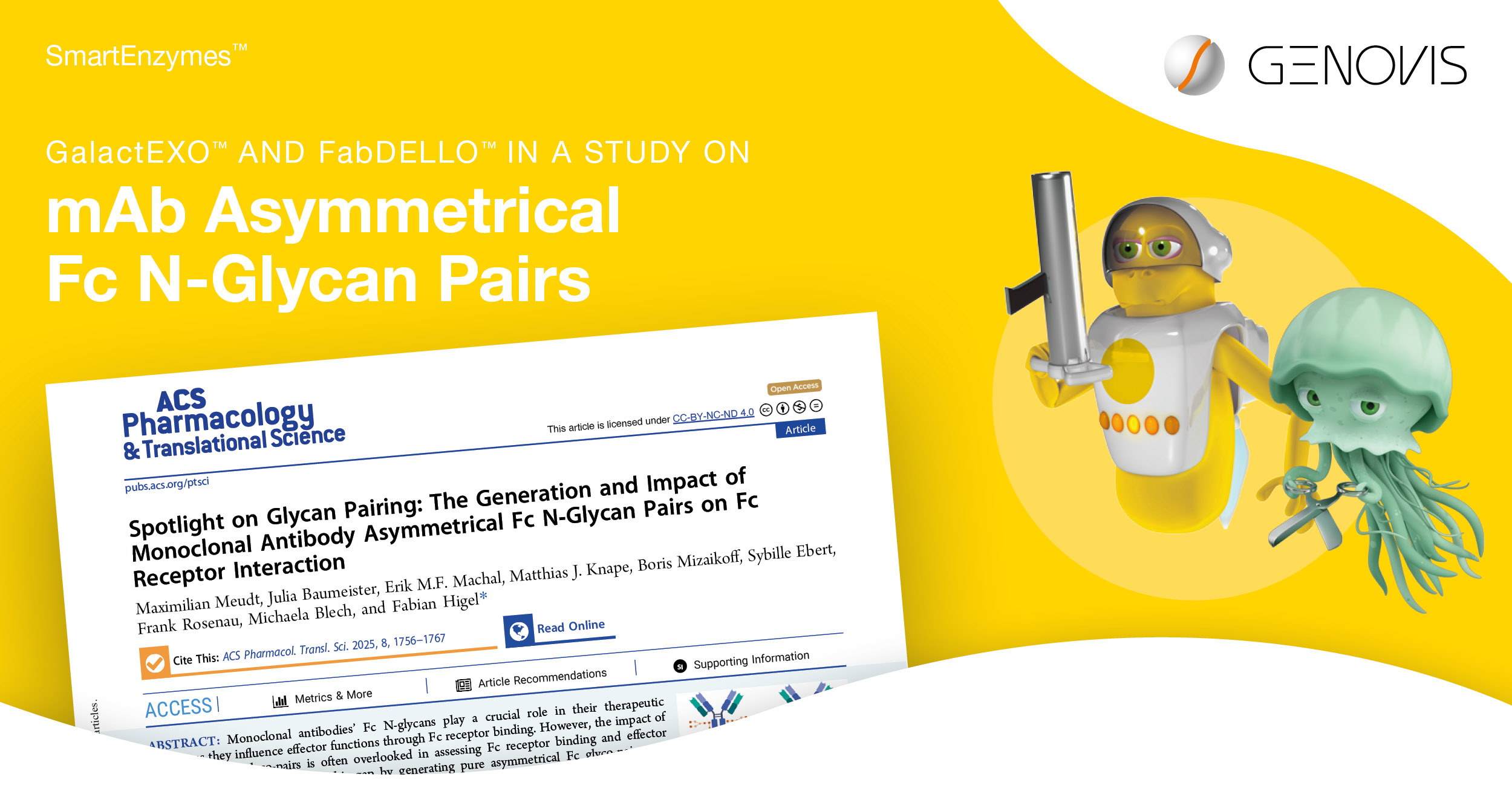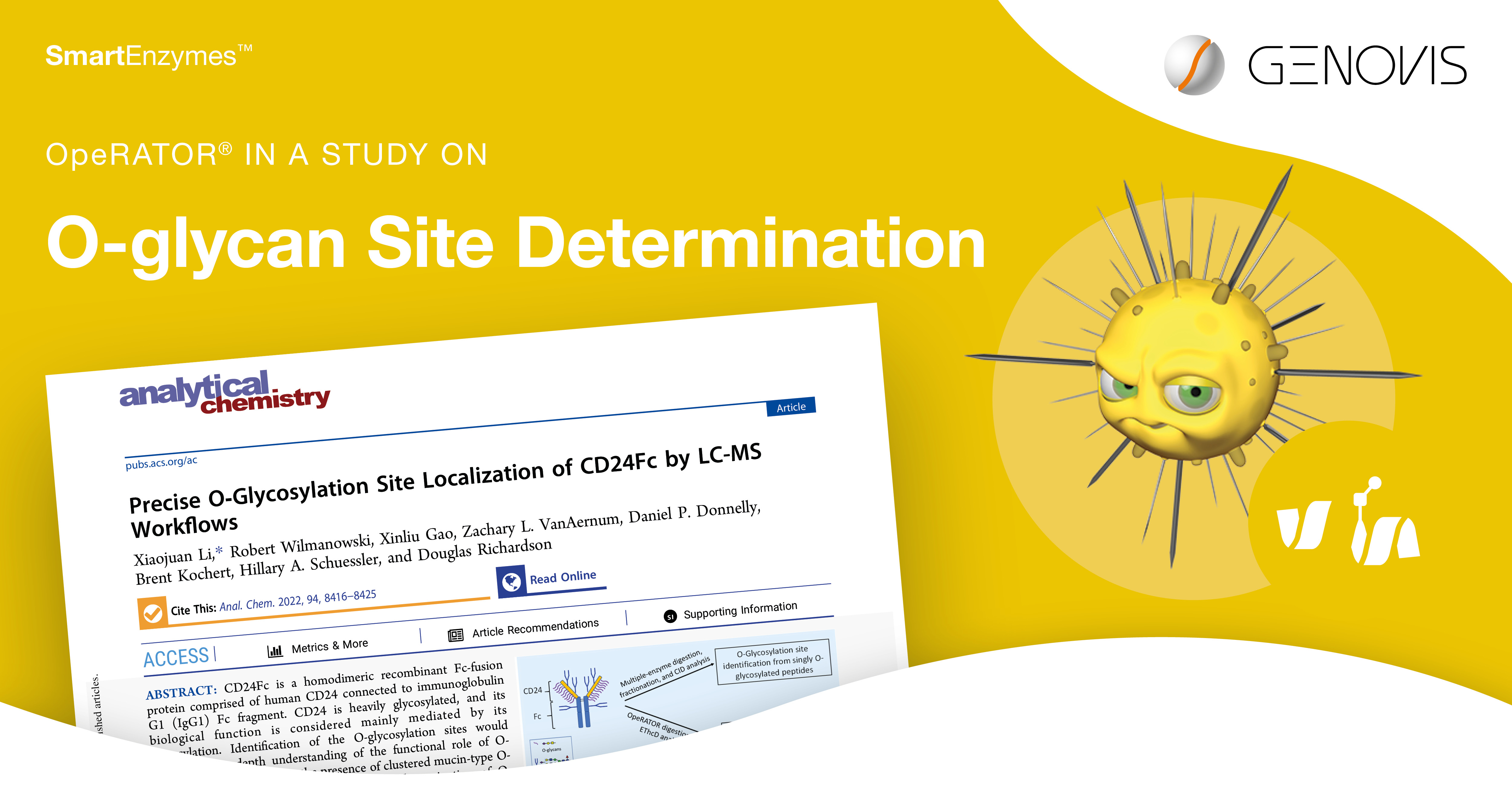Articles in the Category ”Applications”
Tackling Rheumatoid Factor Interference in ADA Assays using IgMBRAZOR™
Researchers at Roche have recently described an elegant solution to address the persistent problem of rheumatoid interference (RF) in anti-drug antibody (ADA) immunoassays. IgMBRAZOR is a unique IgM-specific protease that digests human IgM at one specific site below the CH2 domain in the heavy chain, generating homogeneous F(ab’)2 and Fc fragments. By introducing IgMBRAZOR pretreatment into their experimental setup, the scientists looked to digest IgM antibodies, including those responsible for RF interference, and effectively remove them from serum samples before ADA testing.
Read more »

Understanding the Functional Impact of Monoclonal Antibody Asymmetrical Fc N-Glycan Pairs using SmartEnzymes™
Scientists at Boehringer Ingelheim and collaborators have developed a novel method to generate antibodies with defined asymmetrical Fc glycoforms and evaluate their Fc receptor (FcγRs) binding properties. Combining enzymatic digestion and redox-mediated Fc recombination, Fc fragments with specific glycan pairings could be generated and their Fc receptor binding analyzed by surface plasmon resonance (SPR) spectroscopy.
Read more »

FabRICATOR® Xtra LALA for Ultrafast Microdroplet Digestion of Antibodies with Fc-silencing Mutations
Scientists at New Jersey Institute of Technology, Johnson & Johnson and collaborators have demonstrated a novel approach for mass spectrometry (MS)-based characterization of hinge-mutated antibodies. Combining the recently introduced FabRICATOR Xtra LALA enzyme with ultrafast microdroplet digestion allows for fully automated, high-throughput and efficient antibody characterization, with the entire sample preparation and MS analysis completed in around 1 minute per sample!
Read more »

Multi-Attribute mAb Variant Characterization with CE-MS and FabRICATOR® Digestion
Scientists at Aalen University and their collaborator present a detailed methodology for the rapid and thorough characterization of monoclonal antibody (mAb) variants using capillary electrophoresis-mass spectrometry (CE-MS) at the subunit level. mAbs are an important class of therapeutic molecules for treating various diseases, including cancer and autoimmune disorders. mAbs are large, complex molecules and can undergo a range of post-translational modifications (PTMs), which may affect their biological activity, stability, and therapeutic efficacy. Comprehensive characterization of these modifications is crucial to ensuring the safety and quality of therapeutic mAbs.
Read more »

GlyCLICK®-generated ADC Suppresses Tumor Growth in Pancreatic Cancer Models
Scientists at The Finsen Laboratory and collaborators have described the potential for a novel antibody-drug conjugate (ADC) to treat pancreatic ductal adenocarcinoma (PDAC). The ADC candidate is conjugated with a highly potent anthracycline payload (PNU-159682) using GlyCLICK conjugation technology, and targets uPAR (urokinase plasminogen activator receptor), a protein overexpressed in PDAC and its surrounding stroma. GlyCLICK facilitated the site-specific attachment of the payload to the antibody’s Fc-glycans, ensuring a precise drug-to-antibody ratio (DAR) of 2. This study highlights how GlyCLICK’s precision and efficiency significantly enhanced the development, efficacy, and safety of the ADC molecule.
Read more »

IgMBRAZOR™ in a Study on Structural Characterization of IgM
Scientists at Utrecht University and collaborators have described the use of online SEC combined with Orbitrap-based CDMS to perform real-time kinetic monitoring of pentameric IgM digestion by the protease IgMBRAZOR, a novel protease which digests specifically at a single site in the hinge region of IgM. While IgMBRAZOR was shown to efficiently digest IgM, it was observed that digestion of one of the F(ab’)2 subunits occurred more slowly than the other four. It is suggested that interactions of the J-chain within the pentameric IgM structure may influence the accessibility of the IgMBRAZOR enzyme, thus, impacting the digestion kinetics. SEC-CDMS allows the characterization of heterogeneous and large proteins, enabling unique experimental designs such as monitoring of reaction kinetics from physiological buffers.
Read more »

TransGLYCIT™ in a Study on Antibody Characterization
Scientists from the Wistar Institute in Philadelphia and collaborators have studied the IgG N-glycan structures and inflammatory aging markers of people living with and without HIV to determine a potential structure-function relationship. In this study, TransGLYCIT was used to generate anti-HIV antibodies with defined N-glycan structures to study Fc-mediated immune activities in vitro.
Read more »

GlyCLICK® Enhances Development of Immuno-SPECT/Fluorescent Tracer for PD-L1 in Preclinical Models
Scientists at Université de Bourgogne and collaborators have described the development of a bimodal tracer targeting PD-L1 in human and murine models for preclinical studies. Using a [111In]-DOTA-aza-BODIPY bimodal probe following conjugation onto PD-L1 monoclonal antibodies (mAbs) through either site-specific or random methods, the ability of the bimodal antibodies to selectively identify PD-L1+ tumors were assessed using both fluorescence and SPECT imaging. There were significant benefits observed with the probe generated using the GlyCLICK site-specific conjugation method compared to a random lysine conjugation approach!
Read more »

Mechanistic Insights to Drive Rational Design of Masked Antibodies using FabALACTICA®
Scientists at the University of Cambridge, Astra Zeneca and collaborators undertook mechanistic studies to investigate antibody masking and better understand the parameters involved and their relative impact. FabALACTICA proved to be a valuable tool in this study, allowing the authors to generate antibody subunits. Using the Fab region, as opposed to the full-length antibody, allowed for both higher resolution SEC-MALS experiments to be performed, and supported structural determination of the complexes.
Read more »

Localization of O-glycan Sites in CD24Fc by OpeRATOR® Digestion and LC-MS Analysis
Scientists from Merck & Co. and Glycotope describe the localization of 12 O-glycosylation sites in the heavily O-glycosylated fusion protein CD24Fc by digestion with the O-glycoprotease OpeRATOR in combination with LC-MS analysis. Two different workflows were developed, one based on fractionation in combination with LC-MS/MS CID and one based on LC-MS/MS EThcD. OpeRATOR digestion enabled the localization of O-glycan sites in both workflows and relative quantification of different glycoforms.
Read more »

